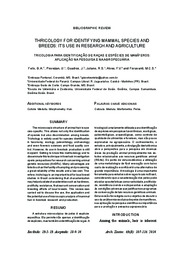Thricology for identifying mammal species and breeds: its use in research and agriculture.
Thricology for identifying mammal species and breeds: its use in research and agriculture.
Autoria: FELIX, G. A.; PIOVEZAN, U.; QUADROS, J.; JULIANO, R. S.; ALVES, F. V.; FIORAVANTI, M. C. S.
Resumo: The microscopic structure of animal hair is species-specific. This allows not only the identification of species but also discrimination among breeds. Trichology is widely used for species identification in taxonomy, ecology, paleontology, archaeology and even forensic sciences and food quality control. However, its use in livestock production is still incipient. Getting to know this methodology and to disseminate this technique in livestock investigation opens perspectives for research concerning animal genetic resources (AnGR s). Many advantages are listed such as the facility of sampling and processing, a great reliability of the results and a low cost. Therefore, trichology is an important tool for local breed studies in Brazil considering that characterization may help elucidate characteristics such as hardiness, prolificity, resistance, that warrant conservation and breeding efforts of local breeds. This review was carried out to discuss the use, the application and the potential use of microscopic analysis of mammal hair in livestock research and production.
Ano de publicação: 2014
Tipo de publicação: Artigo de periódico
Unidade: Embrapa Pantanal
Observações
1 - Por padrão são exibidas publicações dos últimos 20 anos. Para encontrar publicações mais antigas, configure o filtro ano de publicação, colocando o ano a partir do qual você deseja encontrar publicações. O filtro está na coluna da esquerda na busca acima.
2 - Para ler algumas publicações da Embrapa (apenas as que estão em formato ePub), é necessário ter, no celular ou computador, um desses softwares gratuitos. Sistemas Android: Google Play Livros; IOS: iBooks; Windows e Linux: software Calibre.
Acesse outras publicações
Acesse a Base de Dados da Pesquisa Agropecuária (BDPA) para consultar o acervo completo das bibliotecas da Embrapa.

